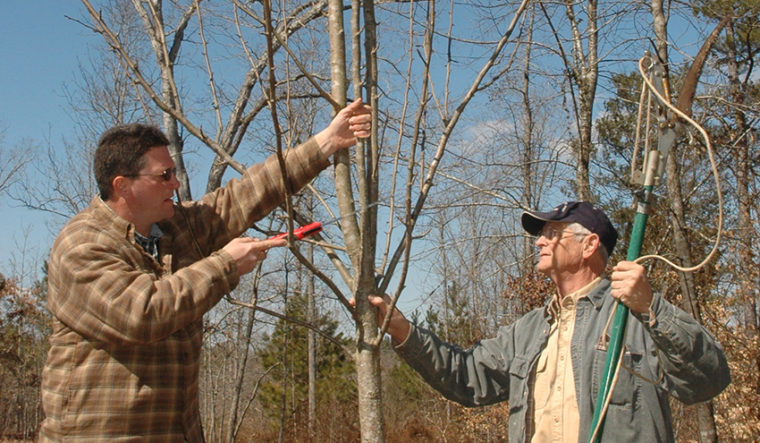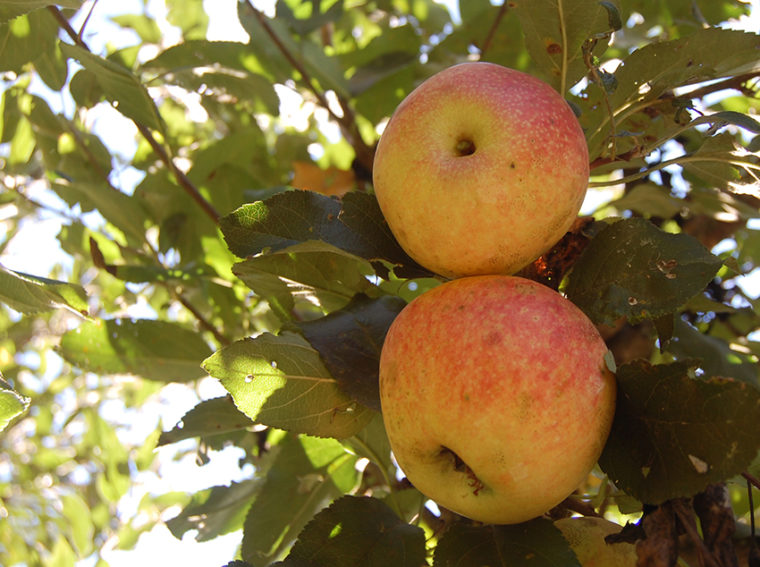Apple trees can provide an ample supply of quality food to whitetails and often retain fruit late into the season, continuing to drop apples into the winter. While establishing new food sources on your property can positively impact the herd’s nutrition, the abandoned, overgrown orchards that pepper the landscape in some regions can offer a great deal with some revitalization. If you are lucky enough to have an old apple tree or orchard where you hunt, consider reclaiming it by following these three steps.
1. Thin Out Competitors
If your apple orchard has been neglected, it is likely you have noticed other trees becoming established. Reducing competition (primarily for sunlight) by removing these pioneers is necessary for the orchard to remain viable. If left to grow unchallenged, their shade will slow fruit production, cause dieback in the crowns of your apple trees and eventually kill them.
The fix here is simple: cut down the competitors. Be sure to use directional felling techniques that will help you prevent damage to your apple trees. If the orchard is surrounded closely by woodland, it may be best to clear out around the orchard as well. The more direct sunlight on apple trees, the better.
2. Prune Your Trees
The main difference between pruning an old apple tree and working with a young one is that you will not be shaping its overall architecture. Rather, the goal is to stimulate the more vigorous growth and improve fruit production. Do this in late winter, when the tree is dormant and will soon have nutrients flowing to the branch tips as spring arrives.

Pruning of apple and pear trees is best done in winter when the tree is dormant.
First, remove all dead and broken branches from the tree. Now you know what you’re working with. Next, get rid of sprouts emerging from the base of the tree. Then remove branches from dense clumps, especially where branches cross or rub against one another. You will want to cut out branches that are pointing downward or inward. Try to retain the healthiest looking ones, especially those that come off the larger limbs at a right-angle. This will allow more light and air to reach remaining branches.
Last, cut back about a third of the newest growth on the branches you have retained, positioning each cut so that a bud is left near the new tip of the branch. Keep in mind that the direction a bud is facing is the direction next year’s growth will take. This will help you guide next year’s branches away from one another.
Do not cut larger limbs that offer needed structural support, and don’t try to do too much pruning in one season.

Leave “scaffold” layers of main branches with space between them. Remove limbs that grow back into the tree or into each other. This leaves space between layers and limbs for flower and apple growth.
3. Manage Surrounding Vegetation
There are different strategies for dealing with understory vegetation in the orchard, and each is based around the desired result. Depending on your strategy, it may be necessary to remove trees that have been felled during the first step.
Regularly mowing between the trees will allow easy access to the interior of the orchard for hunting and for future maintenance. This will also prevent new competitors from being established. However, allowing herbaceous cover to develop between your apple trees will offer additional forage to hungry deer. This would mean mowing less frequently but still in time to suppress encroaching shrubs and tall grasses.
Alternatively, you may choose to let taller, brushy vegetation like shrubs and saplings establish themselves over time. Doing so will provide the sort of dense cover that is good fawning habitat and encouraging to other wildlife like quail, grouse, rabbit, and woodcock. Sprouts emerging from the stumps or roots of trees that you have felled may contribute to this condition. This approach will entail the least frequent maintenance. If following this approach, be sure not to let pioneer-tree heights reach the point of over-topping your apple trees once again!
Other Considerations
Study the health of the trees before you begin. A tree that has been overtopped by competitors long enough may not have the vigor to respond to release. Look for missing bark or large portions of the crown without live buds or without leaves during the growing season. If large portions of a tree are dead or hollow, it may be beyond saving.
Use sharp tools that are appropriate for the size of the branch you are cutting. If fireblight is a problem in your area, clean your tools with rubbing alcohol between trees to prevent spreading.
Don’t fertilize your apple trees for the first season after your rehab. Overabundant nitrogen may result in excessive sprouting. Watch how your trees respond, and go from there. You can also have your soil analyzed, just like soil testing for a food plot, to help identify nutrient deficiencies.
